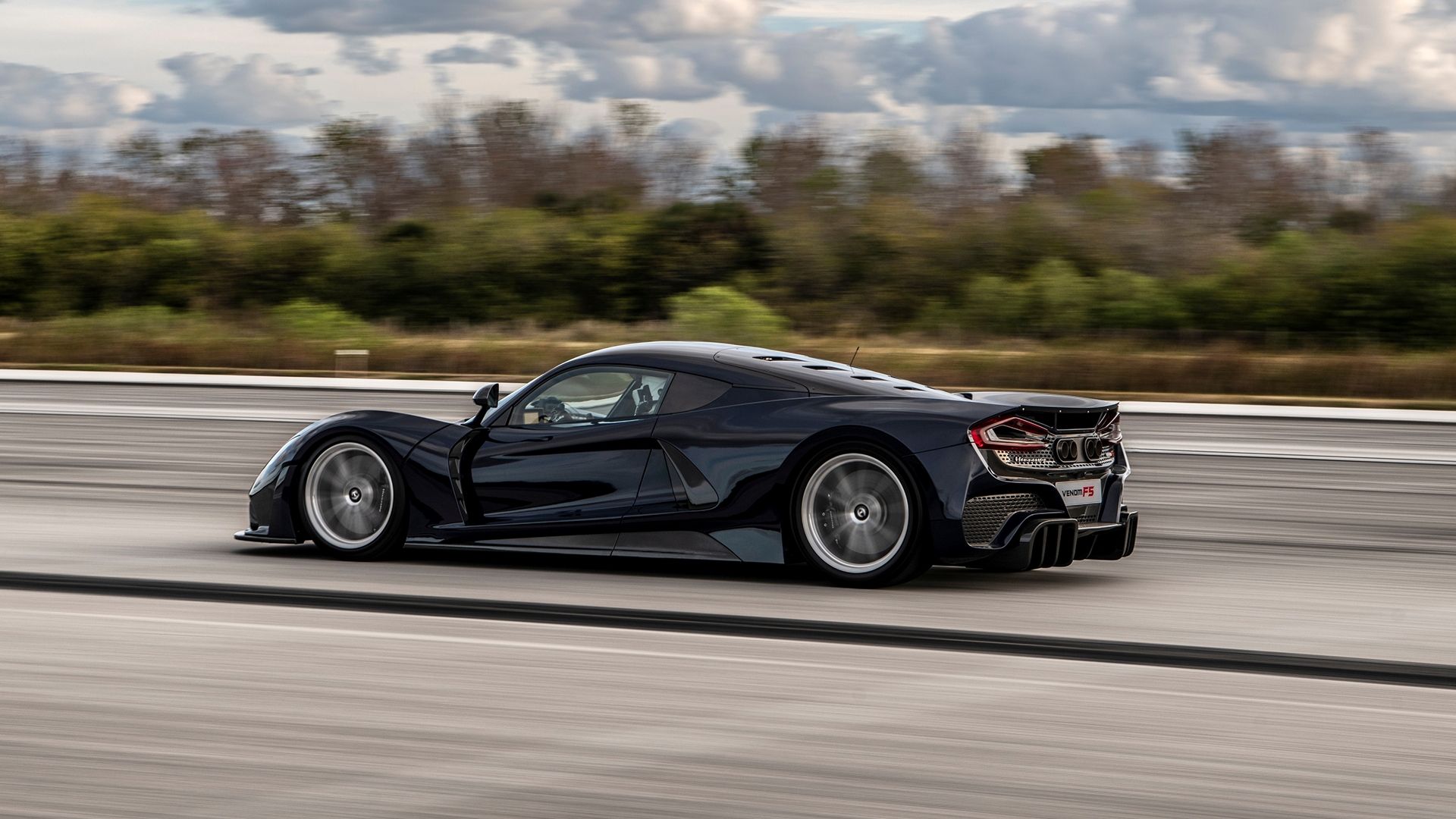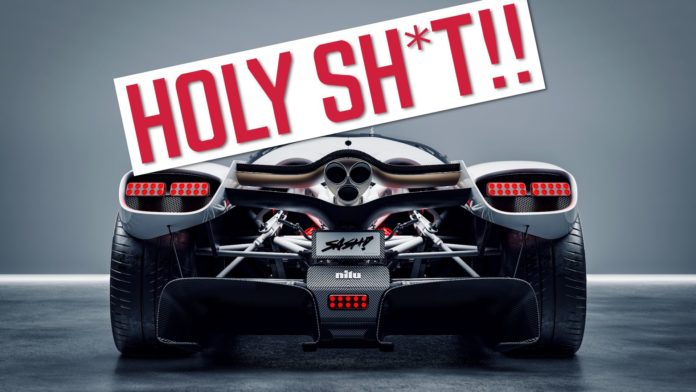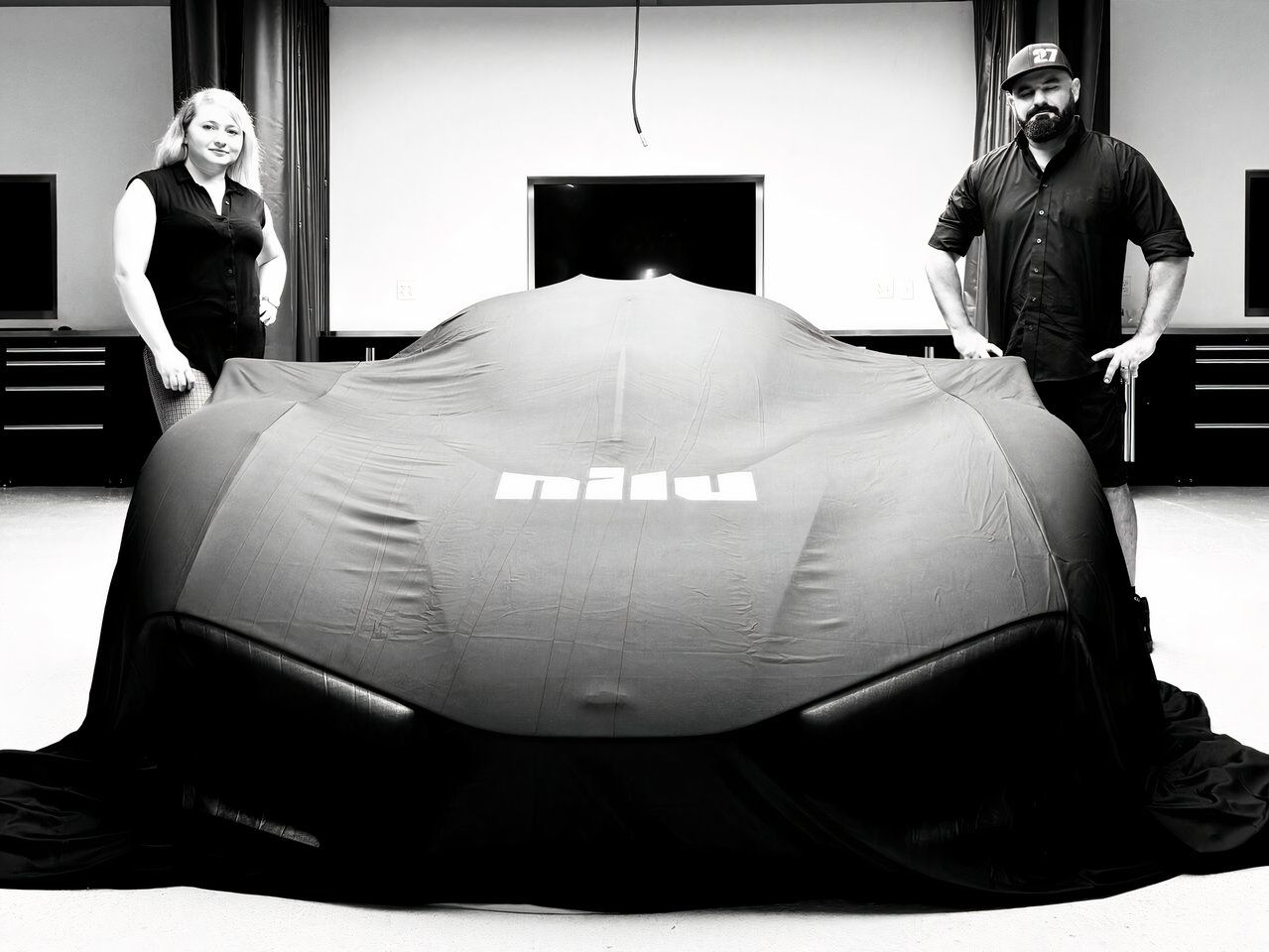If you haven’t yet heard of Nilu27, then get ready, because the latest entrant in the hypercar start-up game is getting ready to step into the limelight during 2024 Monterey Car Week, and it’s bringing back the concept of the “holy s***” hypercar in a big way. Those aren’t our words, those are the words of one of the company’s two founders, Sasha Selipanov, the man previously credited as lead designer at Koenigsegg, with stints before that at Lamborghini, Genesis, and Bugatti.
Sasha Selipanov
Alexander “Sasha” Selipanov is an automotive designer with more than 20 years of automotive experience, and the founder of Nilu27. He has been credited with the designs of more than 50 projects credited to him during his tenure with brands like Koenigsegg, Bugatti, Genesis, Lamborghini, Volkswagen, Audi, Bentley, Hyundai, and more.Notable designs Selipanov has worked on include the Bugatti Chiron, Koenigsegg Gemera, Koenigsegg CC850, Lamborghini Huracan, and Bugatti Vision Gran Turismo.
Ahead of the unveiling of the crazy new NILU hypercar, Sasha sat down with CarBuzz to discuss the brand’s first model and its ambitions for the future.
Nilu27 Fun Fact:
The name Nilu27 is a combination of the founders’ daughters’ names, Nica and Lucia, with 27 being the number on Gilles Villeneuve’s F1 car in one of Selipanov’s most formative memories as a child: seeing the #27 car power sliding out of a corner.
A Hypercar Built Around The Experience, Not Technology
Right from the moment we caught wind of the Nilu27 hypercar – a car that doesn’t have a publicly announced name just yet – we were told it was going to be visceral and engaging, an authentic analog driving experience. Unlike the majority of hypercar makers chasing technology as their mission, Selipanov, and the Nilu27 team are prioritizing how the car feels rather than chasing the latest and greatest technology no one has ever seen.
“There are leading [automotive] companies – some are big and some are small – that all declare that technology is their mission, that they’re turning a page in terms of offering technology that hasn’t been done before. We will not wear technology as our brand-defining mantra.”
– Sasha Selipanov, Co-founder Of Nilu27
In a world where progress seems to be held in higher esteem than emotion, this is a refreshing take echoed by few but appreciated by many, and Selipanov’s commitment to the car’s connection with the driver is something we should applaud. “Wherever there is a fork in the road that has us choose between a potentially technologically advanced, seamless, faster way of doing things or a more direct, more engaging, while potentially less outright fast way of doing things we’d rather go for the more engaging more fun, more emotional approach,” Sasha tells us, explaining that a loss of a tenth of a second in a lap time because of a manual gearshift is “a price we’re willing to pay for the engagement we can offer our clients.”

Add CarBuzz to your Google News feed.
What Selipanov wants to do is bring the most visceral product possible to fruition, within the framework of what legislation allows. It’s not about a perfect lap time or a perfect torque curve on paper. It’s about so much more than that.
“We will not be saying let’s drop manual transmissions because ‘this brand new thing doesn’t need a transmission anymore’ and ‘you can just have seamless torque curve’ and blah, blah, blah,” explains Selipanov.
“We won’t because if there’s a way to bring a manual we will bring a manual, if there is a way to bring a naturally aspirated engine, we will bring a naturally aspirated engine. We want to bring whatever is within the scope of what’s allowed in the most puristic shape to the market.”
Countach Reborn – But Not The Lamborghini
When talking to the brains behind new hypercar companies, it’s not unusual for them to refer to classic supercars for inspiration, but when Selipanov spoke to us, he spoke about “Countach” and not the Lamborghini supercar of the 80s reborn recently for a modern world. Instead, he referred to the origins of the word, as an exclamation of shock: “Countach!” meaning “holy s***!”
“For me, ‘holy s***’ has a lot more to do with the word Countach, which in Piedmont was the way that you would express an emotion similar to ‘holy s***’ and this is to me what proper poster-worthy hypercar should evoke in a 12-year-old kid seeing it, and then awakening this 12-year-old kid within us as a design team, but also within our fans, and especially within our customers is kind of a mission of ours, and the ‘holy s***’ factor is so important.”
Selipanov is playing open cards that his vision of a hypercar is not one for chasing top speed records or insane 0-60 and quarter mile times, likening modern automotive performance to calories in food. When humans were more primitive, the quality of the food mattered less than the quantity you could consume to sustain you, but as food became less of a scarcity, calorie counts became secondary. “That’s why fine dining became valuable,” he explains, “that’s why every person you meet out there these days, they’re a foodie, they’re not just obsessed with taking as many calories as they possibly can. They’re looking for that experience.”
The automotive equivalents of calories are horsepower and seconds, and Selipanov suggests such metrics have become an almost outdated metric of automotive enjoyment. “Outright performance has become so commonplace at this point when you now have a $90,000 Tesla easily out-competing a brand-new Lamborghini and the Lamborghini owner goes home excited when one out of eight attempts at a quarter mile goes their way.”
What Makes Hypercars Special When Performance Is No Longer A Rare Commodity?
We know exotic cars are now matched by electric family sedans, and Sasha rightly asks:
“What’s next for exotic cars if performance is a commodity? If it’s commonplace, there is no more virtue in it.”
Some might argue that 300 mph is the next frontier – the target for Bugatti, Koenigsegg, Hennessey, and more – or outright lap times that require 3.5-4g worth of cornering force to achieve, but is every hypercar buyer a professional race driver who can sustain those forces? “I have personally driven above 200 miles an hour a few times, and I can’t say I wanted to throw another 100 on top of that. So what is the motivation then? [Take the Aston Martin] Valkyrie, as an example, with two and a half, three, three and a half g in the corners; it takes a lot of preparation for the driver to even do a lap as a passenger in that sort of car.

Related
Hennessey Smashes Hypercar Speed Record On The Road To 300 MPH
The 1,817-hp Hennessey Venom F5 has gone faster than Bugatti and Rimac in the half-mile, and the American hypercar wasn’t even trying that hard.
“If outright performance isn’t the target anymore, if binging on calories isn’t what the customer is interested in anymore, what can you offer your customer?” is the question Selipanov asks, before providing the answer, looking to F1 cars of the 1980s.
“They weren’t faster than the cars of today, but they certainly looked more spectacular and made a better sound and have something of a nostalgic factor as well – certainly truckloads of excitement and holy s*** factor about them too.”
No Hybrids – Just Pure V12 Insanity
If you want to capture the essence of ’80s F1 cars, you need an engine capable of delivering spine-tingling aural delight, and for Selipanov, the choice was a naturally aspirated V12 engine. Nilu27 has selected a bespoke 6.5-liter V12 from New Zealand-based Hartley Engines will power the new hypercar, mated to a seven-speed manual gearbox.
With 1,070 horsepower, 634 lb-ft of torque, and a redline somewhere in the vicinity of 12,000 rpm (exact figures haven’t been confirmed), the numbers themselves are extraordinary. Making the V12 all the more remarkable is its hot-vee configuration, with the exhaust an intricate work of art comprising a 12-into-1 3D-printed Inconel exhaust mounted between the banks of the motor. On the outside, six individual throttle bodies (ITBs) per bank promise to provide all the screaming induction noise you can dream of, with the small snippet of the engine below already sounding unlike any other modern V12 we’ve heard.
High-revving V12s have seen a resurgence through automakers like Gordon Murray Automotive and Aston Martin (both using V12s developed by Cosworth), but Selipanov is confident that Nilu27 has “a pretty unique engine configuration that is unlike what Gordon Murray’s car is and what Aston’s is in some ways.” He tells us that, “there is a USP within the engine that makes it unique, cool, and exciting. And through that rearview teaser that we released, it’s pretty obvious that the engine bay takes center stage in the design of the car, so that USP on the engine really helps us celebrate that, you know, how special that rear end actually is.” The engine is completely exposed at the rear of the car, at odds with the rest of the shrink-wrapped body and placing the Hartley V12 on display as a mechanical work of art.
|
NILU Hypercar Specs At-A-Glance |
|
|---|---|
|
Engine |
6.5-liter naturally aspirated V12 |
|
Power |
1,070 hp @ 11,000 rpm |
|
Torque |
634 lb-ft @ 7,000 rpm |
|
Redline |
12,000 rpm |
|
Transmission |
7-Speed Manual |
|
0-62 mph |
Under 3 Seconds |
|
Top Speed |
249 mph (Limited) |
|
Weight |
2,646 lbs (dry weight) |
Production Will Be Less Than (Already Staggering) Demand
Selipanov’s wealth of experience at Koenigsegg, Bugatti, and Lamborghini, among other brands, means he has a wealth of connections – both to people who know what it takes to build a hypercar and people who want to buy them. But Sasha didn’t go and sell cars to prospective buyers beforehand to make this some closed-club affair. “Just from this rear-end reveal (the first image posted of the car), we’ve had so many people ask, [about it], like ‘I want to be the first’ and ‘I would love to have this car’ and it’s been a tremendously warm welcome that this first teaser has received.” Several of those inquisitions have turned out to be serious potential buyers, but Selipanov doesn’t want to sell the car off of a single image.
“I’d love for them to experience the full thing and to sit inside and to get a feel for the dimensions and ergonomics and quality and the rest of the vehicle really.”
But an abundance of interest doesn’t mean the Nilu27 hypercar will be found in abundance.
An exact number for the production run hasn’t been determined (not at the time of our interview, at least), but Selipanov confirmed that he and his co-founder, his wife Inna, want the car to be a rarity. “We definitely want to be sought after and scarce products, so we will not meet market demand, both out of respect to our eventual customers because they need to have an asset that they feel now brings value back to them, and because we’re small and not in a position to make these in large numbers.”
Not Just Another Vaporware Hypercar
As enthusiasts, we’re always excited at the prospect of a new hypercar but have learned to curtail our excitement in light of the number of products that promise much and deliver nothing. But Nilu27 already has a timeline of events once the first car is revealed on August 15 at Pebble Beach.
“We would like to have the first prototypes driving around within 10 months from the unveiling of this car. And as it is pretty typical for a car program these days, I’d say between two and two-and-a-half years until the keys are transferred to the customer.”
That puts us in 2026, which is already shaping up to be a prime year for supercar and hypercar buyers, as Bugatti will deliver the first Tourbillons then and Gordon Murray Automotive should have the first T.33 supercars on the road at around the same time. And that’s exactly the sort of company Nilu27 deserves to be spoken of among, as it’s aiming to attract a similar sort of buyer with similarly deep pockets.
As is always the case with hypercars of this ilk, if you have to ask, you almost certainly can’t afford it, and while Selipanov won’t confirm a price yet – there are a multitude of factors involved in such a colossal undertaking – he did say “we will be within the range of what our competitors.” It doesn’t take a genius to work out this will be at least a seven-figure hypercar, but if it can live up to Selipanov’s vision – both stylistically and from behind the wheel – it’ll almost certainly be worth it.
“It’s the full sensory experience, the entire gamut of what your mind can comprehend. It’s as much tactile and aural as it is visual and as it is the physicality of the experiences. It’s all these things put together and the ‘holy s***’ factor is not only in the driving, but it’s in the rest of that experience too.”
An Eye To The Future: Nilu27 Is An Automaker, Not Merely An R&D Company
Selipanov has had this dream for nearly two decades, with the first sketches being put on paper in 2007, and his work experience since has primed him for this new adventure. “It has taken from 2007 until now, for me and my team to feel confident that we can actually pull it off and in those years, we weren’t idling. I went to work for Lamborghini and Bugatti and Genesis and Koenigsegg, and I learned a hell of a lot from each one of those experiences in very different ways.”
This is by no means a vaporware startup, and with 17 years’ worth of foundations laid, Selipanov is confident Nilu27 will continue to grow. While for now, many manufacturing processes will be outsourced, Nilu27 will eventually bring as much as possible in-house. “The key here is we are a car company; we’re not just R&D and a marketing department combined under one roof,” explains Sasha. “We want to make our cars and will take every step to achieve that […] but that is a long-term vision,” he tells us, explaining that “in the beginning, we will definitely leverage my friends and connections in the industry and use that as a bit of a springboard to eventually achieve our own setup.”


